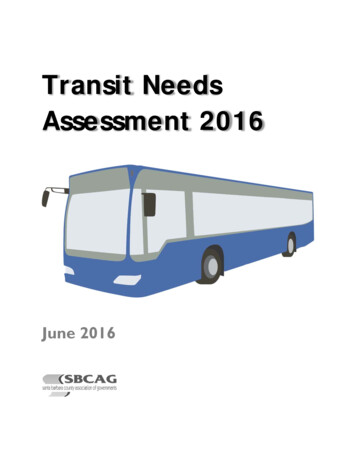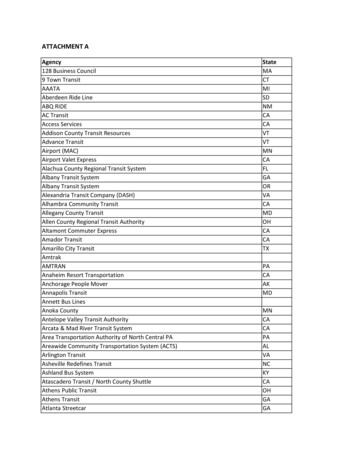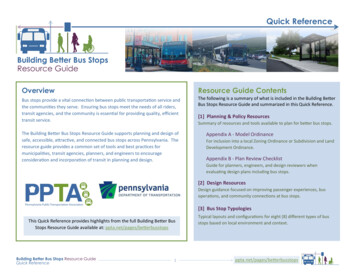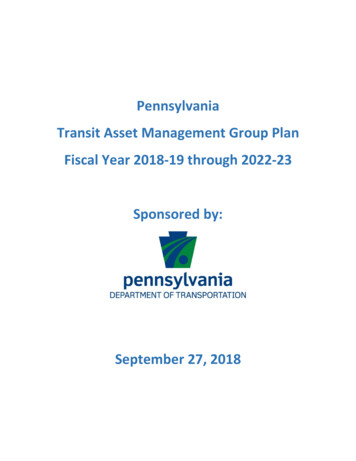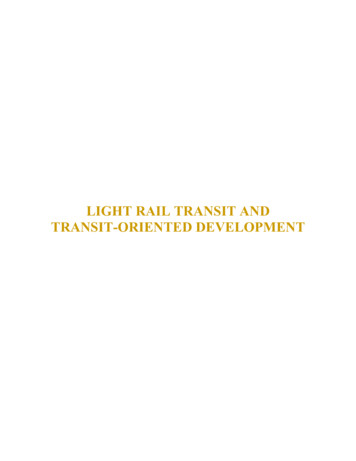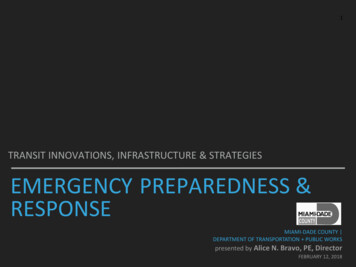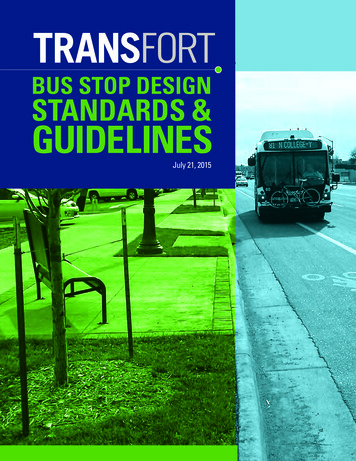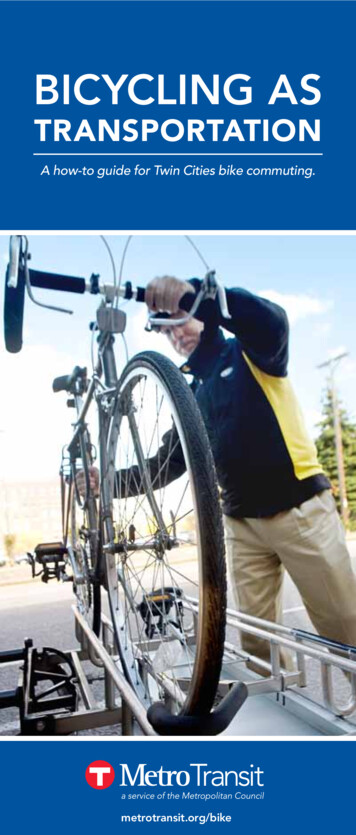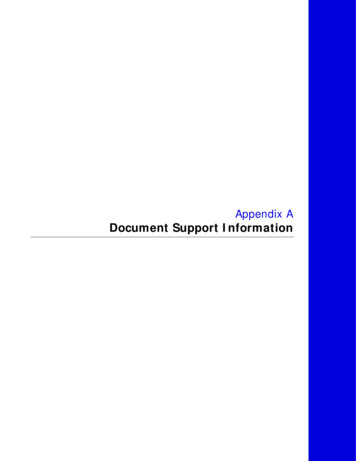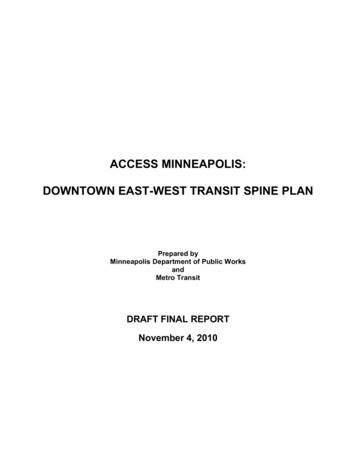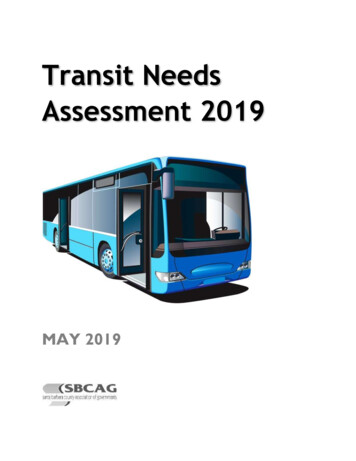
Transcription
Transit NeedsAssessment 2019MAY 2019
Transit Needs Assessment 2019Project StaffMarjie KirnExecutive DirectorMichael BeckerDirector of PlanningJared CarvalhoTransportation PlannerSanta Barbara County Association of Governments260 North San Antonio Road, Suite BSanta Barbara, CA, 93110(805) 961-8900www.sbcag.orgFinancial support for the preparation of this report was provided by the State of California.
2019 Membership RosterSUPERVISORSMemberSupervisorial DistrictDAS WILLIAMSFIRST DISTRICTGREGG HART (Vice Chair)SECOND DISTRICTJOAN HARTMANNTHIRD DISTRICTPETER ADAMFOURTH DISTRICTSTEVE LAVAGNINOFIFTH DISTRICTCITIESMemberAlternateBUELLTONHOLLY SIERRAED ANDRISEKMayorCouncilmemberAL CLARKWADE NOMURACouncilmemberCouncilmemberPAULA PEROTTESTUART KASDINMayorCouncilmemberARISTON JULIANGINA RUBALCABAMayorCouncilmemberJAMES MOSBYJENELLE OSBORNECouncilmemberCouncilmemberCATHY MURILLONONECARPINTERIAGOLETAGUADALUPELOMPOCSANTA BARBARAMayorSANTA MARIASOLVANGALICE PATINO (Chair)ETTA WATERFIELDMayorCouncilmemberRYAN TOUSSAINTKAREN WAITEMayorCouncilmemberEX-OFFICIO (NON-VOTING) MEMBERSCALTRANS DISTRICT 5TIM GUBBINS19th SENATE DISTRICTHANNAH BETH JACKSON33rd ASSEMBLY DISTRICTJORDAN CUNNINGHAM35th ASSEMBLY DISTRICTMONIQUE LIMON
This page is intentionally left blank.
With Special RecognitionSanta Barbara County Transit Advisory Committee(SBCTAC)Representative of:Voting MemberLOCAL SOCIAL SERVICE PROVIDERS FOR PERSONSWITH DISABILITIESBleavins, PollyLOCAL CTSA - Easy LiftParedes, Ernesto (SC)LOCAL SOCIAL SERVICE PROVIDERS FOR PERSONSOF LIMITED MEANSDiaz, Lee (NC)POTENTIAL TRANSIT USERS WHO IS 60 YEARS OFAGE OR OLDERFisher, Sherrie (SC)AGRICULTURAL WORKERSKeller, Fred (NC)TRANSIT USERS FROM SOUTHERN SANTA BARBARACOUNTYKraus, Howard (SC)LOCAL SOCIAL SERVICE PROVIDERS FOR SENIORSLöwen, PetraIndependent Living Resource Center (SC)CITY OF LOMPOC TRANSIT (COLT)Fernbaugh, Richard (NC)SANTA BARBARA METROPOLITAN TRANSITDISTRICT (MTD)Blackerby, Hillary (SC)LOCAL SOCIAL SERVICE PROVIDERS FOR SENIORSCommunity Partners in CaringContreras, Vilma (NC)LOCAL CTSA - SMOOTHSimas, Fil (NC)COUNTY TRANSITDobberteen, Matt (NC)POTENTIAL TRANSIT USERS WHO HAS A DISABILITYStotts, Barry (NC)LOCAL SOCIAL SERVICE PROVIDERS FOR PERSONSWITH DISABILITIESvacant (SC)GUADALUPE TRANSITTalbott, Jim (NC)SANTA YNEZ VALLEY TRANSIT (SYVT)van der Linden, Matt (NC)SANTA MARIA AREA TRANSIT (SMAT)Valdez, Eustaquio (NC)TRANSIT USERS FROM NORTHERN SANTA BARBARACOUNTYZoost, Ed (NC)Children and Families Commission (NC)
This page is intentionally left blank.
Table of ContentsExecutive Summary . 1Chapter 1.Introduction . 2Chapter 2.Consultation . 4Chapter 3.Assessment of Population Characteristics . 5Population Density . 5Transit Dependency Indicator: Vehicle Access . 8Transit Dependency Indicator: Age . 11Transit Dependency Indicator: Low Income. 16Transit Dependency Indicator: Individuals with a Disability . 19Chapter 4.Transportation Services . 23Description of Transit Providers . 23Intercity Transportation Services . 26Specialized Transportation Services . 26Adequacy of Transportation Services . 28Chapter 5.Service Expansions & Improvements . 29Chapter 6.Transportation Needs Assessment & Findings . 32Public Input . 32Analysis . 33Unmet Transit Needs Analysis . 36Reasonable to Meet Analysis . 38Findings . 43Appendix A: Public Outreach Materials . 44Appendix B: Transit Ridership Totals . 51Appendix C: Summary of Public Input . 52Appendix D: SBCAG Resolution . 64
TablesTable 1: Examples of Requests Not Applicable to the Transit Needs Assessment . 33Table 2: FY 2017/18 Farebox Recovery Ratios . 35Table 3: Public Comments Related to Transit Service . 36Table 4: Transit Needs Assessment Findings . 38Table 5: Preliminary Calculations: Santa Barbara to Santa Maria (AM) Service on Clean AirExpress . 40Table 6: Preliminary Calculations: Santa Barbara to Santa Maria Weekend Service on CleanAir Express. 41Table 7: Preliminary Calculations: Santa Ynez Valley to Goleta/Santa Barbara area AfternoonService on Clean Air Express . 42FiguresFigure 1: Transit Needs Assessment Flowchart . 3Figure 2: Population Density – South Coast . 6Figure 3 - Population Density – Lompoc and Santa Ynez Valley. 7Figure 4: Population Density – Santa Maria Valley . 7Figure 5: Zero Vehicle Households - South Coast . 9Figure 6: Zero Vehicle Households - Lompoc and Santa Ynez Valley . 10Figure 7: Zero Vehicle Households - Santa Maria Valley . 10Figure 8: Older Adults (Age 75 and Over) - South Coast . 12Figure 9: Older Adults (Age 75 and Over) - Lompoc and Santa Ynez Valley . 13Figure 10: Older Adults (Age 75 and Over) - Santa Maria Valley. 13Figure 11: Young Adults (Ages 18 to 24) - South Coast. 14Figure 12: Young Adults (Ages 18 to 24) - Lompoc and Santa Ynez Valley . 15Figure 13: Young Adults (Ages 18 to 24) - Santa Maria Valley . 15Figure 14: Low-Income Communities - South Coast . 17Figure 15: Low-Income Communities – Lompoc and Santa Ynez Valley. 18Figure 16: Low-Income Communities – Santa Maria Valley . 18Figure 17: Disabled Population – South Coast . 20Figure 18: Disabled Population – Lompoc and Santa Ynez Valley. 21Figure 19: Disabled Population – Santa Maria Valley . 21Figure 20: Total Transit Ridership - FY 2012/13 through FY 2017/18 . 29Figure 21: Definition - Unmet Transit Need . 34Figure 22: Criteria - Reasonable to Meet . 34Figure 23: Clean Air Express Route Map . 39
EXECUTIVE SUMMARYThe California Transportation Development Act (TDA) provides two major sources of annual funding forpublic transportation—the Local Transportation Fund (LTF) and the State Transit Assistance fund (STA).SBCAG, as the Regional Transportation Planning Agency (RTPA) for Santa Barbara County, administersTDA funding within the region. Transit is the priority use for these funds. If a claimant requests TDAfunds for non-transit (i.e., streets and roads) purposes, SBCAG must first determine whether or notthere are “unmet transit needs” that are “reasonable to meet” within the claimant’s jurisdiction.By regulation, SBCAG must consult with the Social Services Transportation Advisory Council (SSTAC).The Santa Barbara County Transit Advisory Committee (SBCTAC) is SBCAG’s SSTAC. SBCAG consultedwith SBCTAC regarding outreach efforts, public outreach materials, and public input received. Duringthe December meeting, SBCAG presented to the committee a summary of the feedback received fromthe public. The summary included comments from the SBCAG-led public hearing in the city of SantaBarbara, input received from SMAT and COLT unmet needs workshops, and comments received by othermeans, such as email, phone, or mail.SBCAG must also perform an assessment of the size and location of identifiable groups likely to betransit-dependent or transit-disadvantaged in Santa Barbara County. The young, the elderly, andpersons of limited means are more likely than the general population to be transit-dependent. Theassessment found that, with the exception of the elderly population groups, transit-dependentpopulations (such as college-age students, households with no access to a vehicle, people with adisability, and low-income individuals) tend to be concentrated within the same areas throughout theregion (such as Isla Vista, downtown Santa Barbara, central Lompoc, and downtown Santa Maria).Elderly populations tend to be more distributed throughout the region.SBCAG must also analyze existing transportation services. There are a variety of fixed route, demandresponse, commuter, intercity, and specialized services providing transportation in every region in theCounty. Despite declining ridership over the last several years, transit operators in Santa BarbaraCounty continually evaluate, expand, and improve service to meet the demands of the population.SBCAG conducted four public hearings in three locations to identify demand for new and expandedtransit service. SBCAG also accepted public input through transit agency workshops, e-mail, mail, andtelephone.Comments were screened using the Board-adopted definition of “unmet transit need”. These requestsfor new or expanded transit service were then screened through the criteria for “reasonable to meet”.For the 2019/20 cycle, SBCAG finds that there are no unmet transit needs that are reasonable to meet,per the SBCAG-adopted definition of unmet transit needs and the reasonable to meet criteria. Withthis finding, all jurisdictions receiving TDA funds, may use FY 2019-20 TDA funds for non-transitpurposes as requested. This finding, however, does not preclude agencies from voluntarilycoordinating to fulfill any of the other requests for new or expanded service. If implementedvoluntarily, the requests can provide direction for improving transit service in Santa Barbara County.Santa Barbara County Association of Governments 1
Transit Needs Assessment 2019CHAPTER 1. INTRODUCTIONThe California Transportation Development Act (TDA) provides two major sources of annual funding forpublic transportation—the Local Transportation Fund (LTF) and the State Transit Assistance fund (STA).The Santa Barbara County Association of Governments (SBCAG), as the Regional Transportation PlanningAgency (RTPA) for Santa Barbara County established by California Public Utilities Code Section 99401,administers the TDA within the region, allocating TDA funds to eligible claimants (the cities, the County,and transit operators) within its jurisdiction.Transit is the priority use for TDA funds. TDA STA funds may only be used for transit. TDA LTF funds maybe used, under TDA Article 8, for transit services, streets and roads, or pedestrian and bicycle projects;however, LTF funds may be used for streets and roads purposes only if there are no unmet transit needsthat are “reasonable to meet” in the jurisdiction of the claimant proposing to use TDA LTF funds forstreets and roads purposes.If a claimant requests to use LTF funds for streets and roads purposes, SBCAG must first determinewhether or not there are unmet needs that are reasonable to meet within the claimant’s jurisdiction. Tomake this determination, SBCAG must perform an assessment of regional transit needs. The assessment,as designated by the California Public Utilities Code (PUC) Section 99401.5, requires SBCAG to: Consult with the Social Services Transportation Advisory Council (SSTAC) established pursuant to PUCSection 99238. Santa Barbara County’s SSTAC is the Santa Barbara County Transit Advisory Committee(SBCTAC). Identify the transit needs of the jurisdiction(s) that have been considered as part of thetransportation planning process, including the following: oAn assessment of the size and location of identifiable groups likely to be transit-dependentor transit-disadvantaged, including but not limited to young adults, the elderly, the disabled,including individuals eligible for paratransit and other special transportation services.oAn analysis of the adequacy of existing public transportation and specialized transportationservices, including privately and publicly provided services, to implement the plan to meetidentified transit demand.oAn analysis of potential alternative public transportation and specialized transportationservices and service improvements that would meet all or part of the transit demand.Identify the unmet transit needs of the jurisdiction and those needs that are reasonable to meet.o Conduct at least one public hearing for the purpose of soliciting comments on unmet transitneeds that may exist within the jurisdiction and that might be reasonable to meet byestablishing or contracting for new public transportation or specialized transportationservices or by expanding existing services.Adopt by resolution a finding for the jurisdiction after consideration of all available information that:oThere are no unmet transit needs,oThere are no unmet transit needs that are reasonable to meet, oroThere are unmet transit needs, including needs that are reasonable to meet.Santa Barbara County Association of Governments 2
If SBCAG adopts a finding that there are unmet transit needs that are reasonable to meet within ajurisdiction requesting LTF funds for non-transit purposes, the unmet transit needs shall be funded beforeallocating any funds for streets and roads purposes within that jurisdiction. Only upon adoption of afinding that there are “no unmet transit needs” or that there are “no unmet transit needs that arereasonable to meet” may SBCAG allocate funds for streets and roads purposes.The figure below illustrates the transit needs assessment process.Figure 1: Transit Needs Assessment FlowchartSanta Barbara County Association of Governments 3
Transit Needs Assessment 2019CHAPTER 2. CONSULTATIONConsult with the Social Services Transportation Advisory Council (SSTAC) established pursuant to PUC§99238. Santa Barbara County’s SSTAC is the Santa Barbara County Transit Advisory Committee(SBCTAC).The first step in the Transit Needs Assessment process is to consult with the SSTAC, which, for SBCAG, isthe Santa Barbara County Transit Advisory Committee (SBCTAC). This chapter describes SBCAG’sconsultation with SBCTAC. It also explains SBCAG’s other consultation efforts (The public hearings andother public outreach efforts are discussed in Chapter 3).SBCTAC was established as Santa Barbara County’s SSTAC in 2002 in accordance with PUC Section 99238.1SBCTAC is composed of transit users, representatives from fixed route transit and paratransit agencies,and representatives from social service agencies that serve seniors, persons with disabilities, and personsof limited means. SBCTAC meets monthly, as needed, to identify and discuss issues regarding transitneeds, and to review and recommend actions to SBCAG as the RTPA. SBCTAC advises SBCAG on the annualtransit needs assessment and other major transit issues, including the coordination and consolidation ofspecialized transportation services.SBCTAC met to discuss the 2019 Transit Needs Assessment process on September 5, 2018. SBCTACdiscussed options for and provided direction on the public outreach strategy. The committee received areport on plans for local agency transit workshops, evening hearings, and other public input gathering.The committee also approved the type, design, and distribution of public outreach materials (AppendixA).SBCTAC received a presentation on December 5, 2018, with SBCAG staff sharing the public input receivedduring the Unmet Transit Needs public hearings and public comment period. SBCTAC also discussed nextsteps in the Transit Needs Assessment process. On February 6, 2019, SBCTAC received a presentation onthe results of the findings.PUC §99238 states, “Each transportation planning agency shall provide for the establishment of a social servicestransportation advisory council for each county, or counties operating under a joint powers agreement, which isnot subject to the apportionment restriction established in Section 99232.” Committee members must includerepresentation from potential transit users who are 60 years of age or older; potential transit users who havedisabilities; social service providers for seniors, persons with disabilities, and people of low income; and, ifapplicable, social service transportation providers for seniors and persons with disabilities, and the localconsolidated transportation service agency (CTSA).1Santa Barbara County Association of Governments 4
CHAPTER 3. ASSESSMENT OF POPULATION CHARACTERISTICSIdentify the transit needs of the jurisdiction(s) that have been considered as part of thetransportation planning process, including: An assessment of the size and location of identifiable groups likely to be transit-dependent ortransit-disadvantaged, including but not limited to the elderly, the disabled, includingindividuals eligible for paratransit and other special transportation services, and persons oflimited means.This chapter provides an existing-condition assessment of the population of Santa Barbara County byidentifying and locating groups likely to be transit-dependent or transit-disadvantaged. Being transitdependent means having to rely on transit services instead of an automobile to meet one's travel needs.Transit-dependent persons generally either do not have access to a vehicle or are unable to operate avehicle. The elderly and low-income individuals are more likely than the general population to be transitdependent.POPULATION DENSITYThe distribution and density of the region’s population is among the most important factors influencingthe viability of transit service because transit trips require connecting to/from the bus on at least oneend of the trip. Higher density communities have more people within a shorter distance of commoncorridors that might support transit. Together with employment density, population density willdetermine the success of transit more than any other factor. Data from the 2010 U.S. Census has beenmapped at the census tract level to illustrate the population distribution throughout Santa BarbaraCounty (Figures 2 - 4). Key population density findings include: Areas of high population density include east Isla Vista, Cottage Hospital/Downtown, Westsideand Eastside/Milpas areas of Santa Barbara, areas of downtown Lompoc, and the western side ofSanta Maria.Areas of moderate population density include Old Town Goleta, west Isla Vista, Carpinteria, theUpper East Side, San Roque, and Waterfront areas of Santa Barbara, central Lompoc, Orcutt, andthe downtown and northern Santa Maria.Santa Barbara County Association of Governments 5
Transit Needs Assessment 2019Figure 2: Population Density – South CoastSanta Barbara County Association of Governments 6
Figure 3 - Population Density – Lompoc and Santa Ynez ValleyFigure 4: Population Density – Santa Maria ValleySanta Barbara County Association of Governments 7
Transit Needs Assessment 2019TRANSIT DEPENDENCY INDICATOR: VEHICLE ACCESSIndividuals without access to a vehicle represent a particularly strong market for transit. Identifyinghouseholds without a vehicle helps in identifying areas that are likely to have a significant number oftransit-dependent riders. Data from the U.S. Census’ American Community Survey 5-Year Estimates 20122016 was used to identify households without a vehicle. Figures 5 - 7 display the percentage of zerovehicle households at the census tract level. Locations with the highest concentrations of zero-vehiclehouseholds include Isla Vista, Downtown, Hitchcock, and Samarkand areas of Santa Barbara, northwestand southeast Lompoc, and downtown Santa Maria.Santa Barbara County Association of Governments 8
Figure 5: Zero Vehicle Households - South CoastSanta Barbara County Association of Governments 9
Transit Needs Assessment 2019Figure 6: Zero Vehicle Households - Lompoc and Santa Ynez ValleyFigure 7: Zero Vehicle Households - Santa Maria ValleySanta Barbara County Association of Governments 10
TRANSIT DEPENDENCY I NDICATOR: AGEOlder adults (for purposes of the Transit Needs Assessment, those 75 years and older) are more likely touse transit than the general population because they are more likely to have chosen to stop driving orcan no longer drive. Data from the U.S. Census ACS 2012-2016 was used to map the distribution ofindividuals aged 75 and older. Figures 8 - 10 show the percentage of the population 75 years and olderby census tract throughout Santa Barbara County. Key findings are as follows: High concentrations of older adults reside in Montecito, and the Samarkand, Hidden Valley, andHope Ranch areas of Santa Barbara.Moderate concentrations exist in neighborhoods elsewhere in the region but are less contiguous.The young adult population (students and non-students) are a growing transit market as attitudes towardstaking transit change and fewer young adults own a vehicle. Data from the U.S. Census ACS 2012-2016was used to map the percentage of individuals aged 18 to 24 (young adults) by census tract. Figures 11 13 show the geographic distribution of young adults throughout Santa Barbara County. A number offindings are apparent: High concentrations of college age residents can be found surrounding the UC Santa Barbara,Santa Barbara City College, and Westmont College campuses on the South Coast, as well as theEastside of Santa Barbara.Young adults are more dispersed in the North County with the exception of Vandenberg Air ForceBase.Vandenberg Air Force Base has a high concentration of young adults.Santa Barbara County Association of Governments 11
Transit Needs Assessment 2019Figure 8: Older Adults (Age 75 and Over) - South CoastSanta Barbara County Association of Governments 12
Figure 9: Older Adults (Age 75 and Over) - Lompoc and Santa Ynez ValleyFigure 10: Older Adults (Age 75 and Over) - Santa Maria ValleySanta Barbara County Association of Governments 13
Transit Needs Assessment 2019Figure 11: Young Adults (Ages 18 to 24) - South CoastSanta Barbara County Association of Governments 14
Figure 12: Young Adults (Ages 18 to 24) - Lompoc and Santa Ynez ValleyFigure 13: Young Adults (Ages 18 to 24) - Santa Maria ValleySanta Barbara County Association of Governments 15
Transit Needs Assessment 2019TRANSIT DEPENDENCY INDIC ATOR: LOW INCOMELow-income individuals are more likely than the general population to be transit-dependent. Data fromthe U.S. Census ACS 2012-2016 was used to map individuals of low income, measured by the percentageof people whose income in the past 12 months is below the poverty line. The data is mapped at thecensus tract level and displayed in in Figures 14 – 16.Communities with higher concentrations of low-income individuals are located in Isla Vista, Lompoc,Santa Maria, and Downtown and Eastside Santa Barbara.Santa Barbara County Association of Governments 16
Figure 14: Low-Income Communities - South CoastSanta Barbara County Association of Governments 17
Transit Needs Assessment 2019Figure 15: Low-Income Communities – Lompoc and Santa Ynez ValleyFigure 16: Low-Income Communities – Santa Maria ValleySanta Barbara County Association of Governments 18
TRANSIT DEPENDENCY I NDICATOR: INDIVIDUALS WITH A DISABILITYIndividuals with a disability are more likely than the general population to be transit-dependent.However, given the wide-range of disability classifications, people with a disability are certainly capableof owning and operating a vehicle.2 Data from the U.S. Census ACS 2012-2016 was used to map thedistribution of disabled people throughout Santa Barbara County. The data is measured at the censustract level and displayed in Figures 17-19.Communities with higher concentrations of disabled people are generally located around urban areas ofSanta Barbara, Goleta, Isla Vista, and Carpinteria. Vandenberg Village has a larger number of disabledpopulation relative to other places in the county. In North County, southern Santa Maria and the area tothe northwest of Santa Maria have higher concentrations of disabled people. Disabled people are likelyconcentrated in and around urban areas due to the provision of disability services in those areas.The Census Bureau collects data on disability primarily through the American Community Survey (ACS) and theSurvey of Income and Program Participation (SIPP). The definitions of disability are not always alike so cautionshould be taken when making comparisons across surveys. Generally, the SIPP estimates of disability prevalenceare broader and encompass a greater number of activities on which disability status is assessed.2Source: out.htmlSanta Barbara County Association of Governments 19
Figure 17: Disabled Population – South CoastSanta Barbara County Association of Governments 20
Figure 18: Disabled Population – Lompoc and Santa Ynez ValleyFigure 19: Disabled Population – Santa Maria ValleySanta Barbara County Association of Governments 21
In conclusion, this assessment found that, with the exception of the County’s elderly and disabledpopulations, transit-dependent populations (such as college-age students, households with no access toa vehicle, and low-income individuals) tend to be concentrated within the same areas throughout theregion (Isla Vista, downtown Santa Barbara, central Lompoc, and downtown Santa Maria). Elderlypopulations tend to be more dispersed and less contiguous throughout the region. Disabled populationstend to be more concentrated near urban areas. As shown in the figures, all of the areas in which transitdependent populations are located have access to transit.Santa Barbara County Association of Governments 22
CHAPTER 4. TRANSPORTATION SERVICESIdentify the transit needs of the jurisdiction(s) that have been considered as part of thetransportation planning process, including: An analysis of the adequacy of existing public transportation and specialized transportationservices, including privately and publicly provided services, to implement the plan to meetidentified transit demandThe next step in the Transit Needs Assessment process, described in this chapter, is to identify SantaBarbara County’s existing public transportation and specialized transportation services, includingprivately and publicly provided services. The transportation services in Santa Barbara County that servetransit-dependent individuals and others include fixed route and demand response service, commuterservice, intercity service via Amtrak and Greyhound, and specialized transportation service. This chapteralso analyzes the adequacy of these services to meet the transit demand identified in the previouschapter.DESCRIPTION OF TRANSIT PROVIDERSMTD (Santa Barbara Metropolitan Transit District)MTD, the largest transit service provider in Santa Barbara County, provides fixed route local servicewithin the South Coast area of Santa Barbara County seven days a week. It serves approximately 52square miles, between the Ventura County border to the east and Winchester Canyon at the westernedge of Goleta. It encompasses the communities of Santa Barbara, Goleta, Carpinteria, Montecito,Summerland, and Isla Vista, and serves nearly 800 bus stops. Service on MTD’s 51 transit routes (28regular routes and 23 school boosters) begins as early as 5:30 AM and runs as late as midnight. Americanswith Disabilities Act paratransit service is provided by Easy Lift Transportation under a Memorandum ofUnderstanding.SMAT (Santa Maria Area Transit)SMAT, the largest transit service provider in North Santa Barbara County, provides fixed route anddemand response service Monday through Friday from 5:30 AM to 10:30 PM, Saturday from 7:30 AM to7:10 PM, and Sunday from 7:30 AM to 7:10 PM. It operates 8 routes, serving Santa Maria, Orcutt, andTanglewood.Santa Maria also operates the Breeze bus, which serves Santa
Independent Living Resource Center (SC) CITY OF LOMPOC TRANSIT (COLT) Fernbaugh, Richard (NC) SANTA BARBARA METROPOLITAN TRANSIT DISTRICT (MTD) Blackerby, Hillary (SC) LOCAL SOCIAL SERVICE PROVIDERS FOR SENIORS Community Partners in Caring Contreras, Vilma (NC) LOCAL CTSA - SMOOTH Simas, Fil (NC) COUNTY TRANSIT Dobberteen, Matt (NC)
